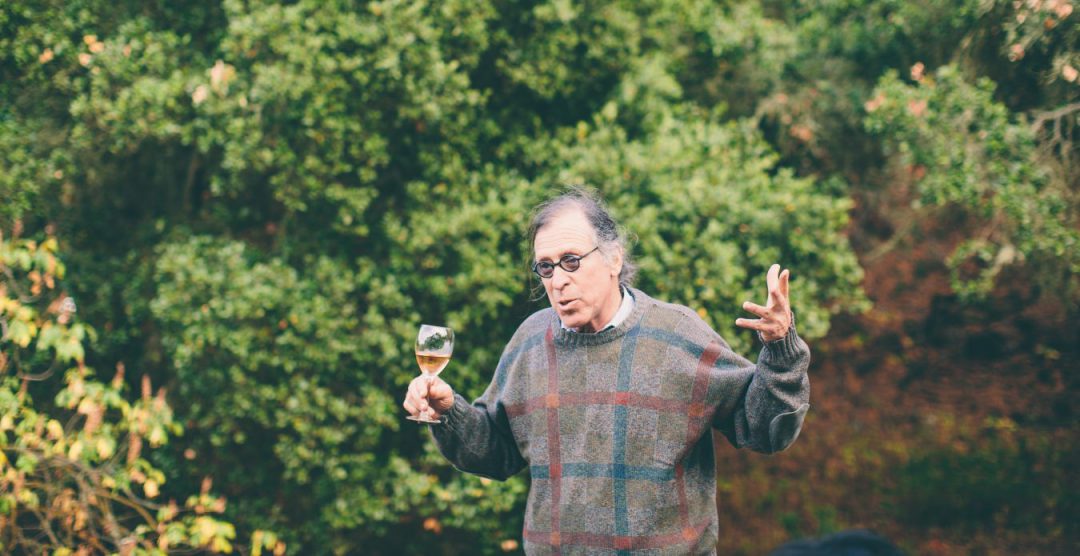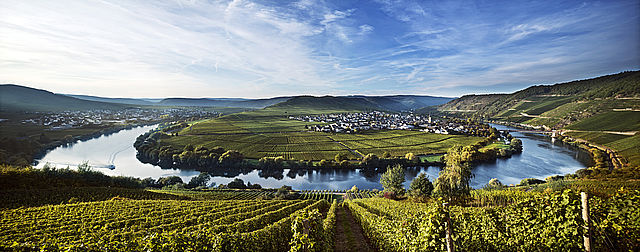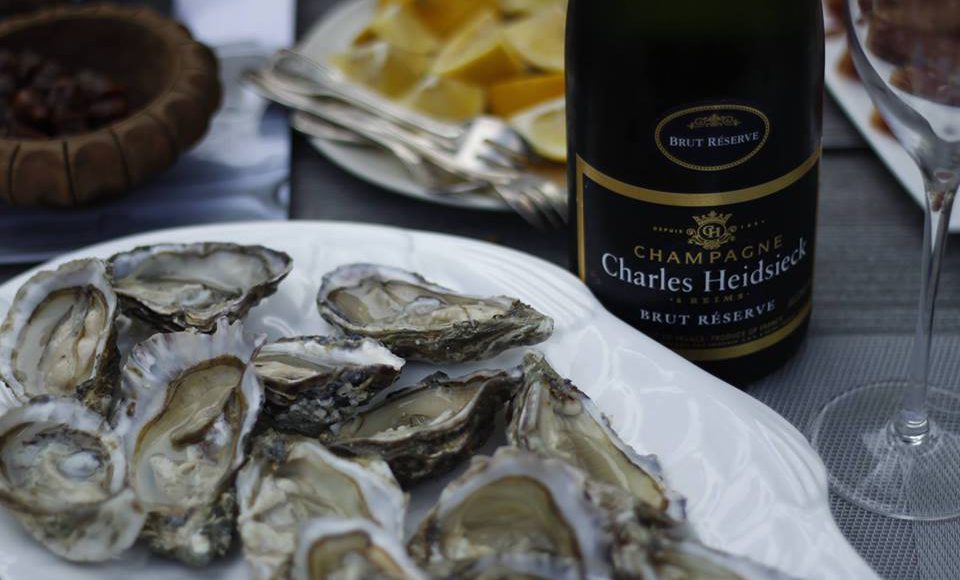Photo credit: Nicole diGiorgio sweetnessandlightphoto.com/ Bonny Doon Vineyards
The ambition of many a vineyard-owning winemaker is to craft the finest possible vin de terroir. It is a lofty notion – the story of one vineyard’s specific climate, soil type, orientation, and so forth, expressed through its grape variety(ies) and through the winemaker’s touch, to create a unique wine that could only come from that specific place and vintage.
Randall Grahm is a renowned Californian wine producer; founder of the Santa Cruz-based Bonny Doon Vineyard. Grahm has focused on the pursuit of terroir wines since selling his major brands: Big House Red, Pacific Rim, and Cardinal Zin back in 2006. At a recent tasting in Montréal, Grahm waxed lyrical on the subject.
Grahm separates wines into two categories: those that express winemaking technique, and those that convey provenance.
Grahm separates wines into two categories: those that express winemaking technique, and those that convey provenance. Both are of value. Not every vineyard site has superior qualities. Many are simply adequate to the task of producing good value, easy-drinking wine. And there is nothing wrong with that. A skilled winemaker can enhance quality using a variety of specialized techniques, but the resultant wines will never provoke the kind of “emotional or psychic resonance” Grahm attributes to terroir wine.
In certain, very special vineyards the world over, wine producers have observed a curious phenomenon. Despite using similar grape growing and winemaking techniques as practiced in neighbouring vineyards, the wines from these sites are different, and inexplicably better. They possess a sort of ethereal beauty that stirs the soul. In long established vineyard regions, these plots have been identified with special names or hierarchical classifications like Grand Cru, Grosse Lage, etc.
Grahm has traveled widely, and tasted terroir wines from across the globe. The one common factor he perceives in all of them is minerality. This buzz word is a hot topic of debate in wine circles. Wine writers (yours truly included) regularly describe wines like Chablis or Mosel Riesling as mineral – generally meaning that they smell of wet stone or struck flint, or that they provoke a prickly textural sensation on the palate separate from acidity or carbonation.
“Before I die, one thing that I want to know is…what is minerality?”.
Earth Science experts dismiss minerality as hogwash. A vine’s mineral uptake is so minute in quantity as to be imperceptible to the nose or palate, they say. Theories abound on what causes these flavour compounds, but for now, no common consensus has been reached.
“Before I die, one thing that I want to know is…what is minerality?”. Grahm views minerality as a “function of greater resistance to oxidation”; an essential “life force” possessed by terroir wines. He sees a correlation between this mineral expression and “a presence of higher concentrations of minerals in soil, a favourable ratio of grape root mass to fruit mass, and healthy microbial life in the soil”. These are the conditions that Grahm is working with in his vineyard.
In a quiet corner of the San Benito County AVA, an inland area of the Central Coast of California, Grahm found Popelouchum. This 113-hectare vineyard in San Juan Bautista was a former settlement of the Mutsun people, a subset of the Ohlone tribe. The word means paradise in their dialect, and this is just what Grahm feels he has found.
Every effort is being taken here to ensure that the full potential of the site is expressed through the grapes. Dry farming using sustainable and biodynamic practices, low yields, moisture retaining biochar for soil amendments, and so forth.
Grahm muses that minerality gives wines an essential “life force” that sets them apart.
Grahm has even dedicated a portion of the vineyard to experimenting with growing grape crossings from seed. His ambition is to create new varieties perfectly suited to his land (and similar such vineyards) – with the necessary disease and drought resistance, along with an elegant, and refined flavour profile. This is important work in an era where climate change is dramatically altering growing conditions, making grapes once ideally suited to a site no longer viable.
The Popelouchum project is still in its infancy. The sole release, a 2015 Grenache grown from ungrafted vine cuttings taken from Château Rayas in Châteauneuf-du-pape, is incredibly vibrant with a highly perfumed, complex nose, silky structure, and persistent, dare-I-say mineral-laced finish. Sadly, you won’t find it on liquor store shelves. The bottling was so small that Grahm is sharing it privately with friends and enthusiasts. Commercial sales are still a couple of vintages down the road.
In the meantime, there are a wide range of Grahm’s Bonny Doon Vineyard wines on offer to distract us. They may not be the absolute expression of terroir that Grahm now seeks, but they certainly are skillfully made and very pleasant to drink.
My top 5 from this weeks’ tasting include:
(What do VW, PW, LW mean? Check out my wine scoring system to find out.)
Bonny Doon Vineyard Vin Gris de Cigare 2017 – 87pts PW
Pretty pale rose in colour. Subtle floral, and red apple hints feature on the nose. This tempting rosé really comes alive on the crisp, creamy textured palate. Light in body, moderately firm, with concentrated, tangy orchard fruit flavours.
Blend: Grenache, Mourvèdre, Grenache Blanc, Roussanne, Carignan
Where to buy: SAQ (22.75$)
Bonny Doon Vineyard Proprio Gravitas 2015 – 88pts PW
Attractive Sémillon character, with notes of lanolin, lemon zest, acacia, and exotic spice on the nose. Fresh, medium in body, with a smooth, rounded mouthfeel and pithy grapefruit notes on the finish.
Blend: Sémillon, Sauvignon Blanc, Muscat
Where to buy: SAQ (20.00$)
Bonny Doon Vineyard Le Cigare Blanc 2014 – 92pts PW
Absolutely killer quality for the price. Sourced from a single parcel, the Beeswax vineyard in Monterrey County. Intriguing aromas of fennel, anise, ripe lemon, apricot, and hints of toasty oak keep you coming back for more. The palate displays excellent balance, with fresh acidity, an ample frame, and highly concentrated, baked pear and spice flavours. Beautifully creamy and layered in texture. Just a shade warming on the finish.
Blend: Grenache Blanc, Roussanne
Where to buy: SAQ (35.00$)
Bonny Doon Vineyard Le Cigare Volant 2012 – 90pts PW
Quite earthy and brooding in nature, with aromas of licorice, black cherry, hints of pepper, and dried floral notes. Fresh and full-bodied, with a firm structure and ripe, grippy tannins. Moderate concentration of juicy, brambly red and dark fruit gives way to cigar box and spiced notes on the medium-length finish.
Blend: Mourvèdre, Grenache, Syrah, Cinsault
Where to buy: SAQ (40.00$)
Bonny Doon Vineyard Old Telegram 2016 – 93pts LW
Lovely floral nose, underscored by hints of dried orange peel, fresh cranberries, raspberries, and black cherry. This weighty, highly concentrated red really shines on the palate, with vibrant acidity, and well-integrated cedar-spice from mainly older oak ageing. The tannins are very elegant; fine-grained and ripe. The finish is long, earthy, and fresh.
Blend: 100% Mourvèdre
Where to buy: Enquire with agent, Trialto



